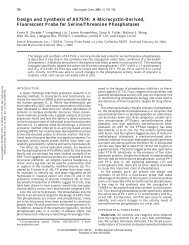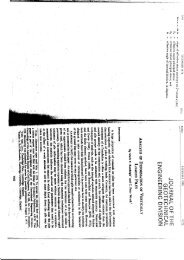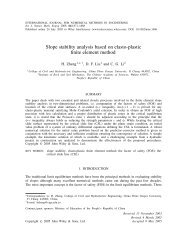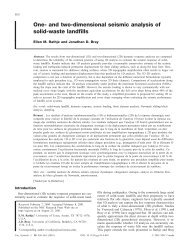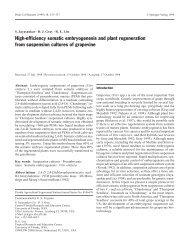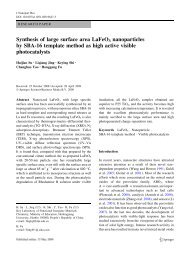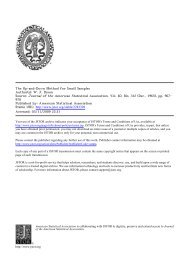PROPAGATION OF ELASTIC WAVES IN LAYERED MEDIA BY ...
PROPAGATION OF ELASTIC WAVES IN LAYERED MEDIA BY ...
PROPAGATION OF ELASTIC WAVES IN LAYERED MEDIA BY ...
Create successful ePaper yourself
Turn your PDF publications into a flip-book with our unique Google optimized e-Paper software.
3~ BULLET<strong>IN</strong> <strong>OF</strong> THE SEISMOLOGICAL SOCIETY <strong>OF</strong> AMERICAscheme. It is the same as the vertical and horizontal solid curves for r/H =6.28(~ = 45 °) given in Figure 24 of the paper by Alterman and Abramovici (1966).The agreement is excellent.In Figures 12 and 13 we show the effect of depth and pulse width on the appearanceof the Raylcigh wave. In both figures the horizontal distance of the observationpoint is held fixed at a distance of six source depths from the source. The first curveshows the observation point on the surface, the second curve shows the observationpoint at a distance of one-half source depth below the surface, and the third curveshows the observation point at one source depth below the surface. Figure 12 showsthe variation with depth when the pulse width is 45 = .8, and Figure 13 shows thevariation with depth when the pulse width is 4A = 1.6. Note that the series inFigure 12 has higher frequencies than the series in Figure 13 since A is smaller.Consequently, the Rayleigh wave at the same depth gets more damped for the higherfrequencies. The damping of the Rayleigh wave depends both on the depth of sourceand depth of observer. Therefore, the ratio of the amplitude of the Rayleigh waveto the direct wave on the surface is larger for large A than for small A. Compare thefirst curves in Figures 12 and 13. Next observe that the amplitude of the directwave in the first curve is larger than in the other two because it contains the reflectedwave in addition. In the other two, the reflected peak appears separately.For fixed A the amplitude of the Rayleigh wave decreases with depth. We notice,however, that the horizontal component of the Rayleigh wave decreases faster withdepth than the vertical component. By continuing the depth series to larger depths,one finds a change from retrograde to prograde motion. The third curves in Figures12 and 13 show that the vertical component of the direct wave is zero (as expectedfor the horizontal path of the direct wave). The vertical component in the secondcurve in Figure 12 is small, and the second curve in Figure 13 is only slightly noticeabledue to the overlapping with the reflected pulse.(4) Refraction Series. Fig~ares 14 and 15 show a series of curves for five differentobservation points located along the surface of a layered half-space when the shearand compressional speeds in the lower medium are much larger than in the layer.The properties assumed for the surface layer and lower medium are Xl = ~1,p2 = 1.5pl, Vc2 = 3va and v~2 = 3va. Hence v~2 > v82 > vc~ > va. A point source ofcompressional waves with a pulse width of 4A = .8 is located midway between thesurface and interface. The observation points in Figure 14 are located at the epicenterand on the surface at a distance of one layer thickness away from the epicenter. Theobservation points i~ Figure 15 are located on the surface at distances of two, threeandfour-layer thicknesses away from the epicenter. The two figures together form aseries showing the development of the refraction arrival. With increasing distanceof observer from the source, the refracted wave P1P2PI becomes more clearly separatedfrom the later arriving waves. Subscripts 1 or 2 attached to either P or Sdenote the medium in which the ray propagates. In the last two curves of Figure 15,it is completely separated from the later arriving direct wave and from other refractedand reflected waves. In the present model all the refracted waves, includingP1P2Sx, PIS1P1 and P1S2S ~ exist. However, their arrival times are too close one toanother and to the arrival'0f the direct and reflected pulses to be noticed separately.The arrival times of pulse maxima are indicated in the figures by arrows. In order tosee more clearly the refraction arrival travelling at the shear speed in the lower



